Simon Guerrier's Blog, page 12
October 10, 2024
Doctor Who Magazine #609
 The latest issue of the official Doctor Who Magazine is out now, and very excitingly comes with an exclusive Target novelisation of the 1967 story The Evil of the Daleks, written by Frazer Hine with Mike Tucker and Steve Cole as his companions. In fact, it's a novelisation of the 1968 repeat of that story. Another quite good book about The Evil of the Daleks is also available. My contribution this issue is the latest Script to Screen feature, this time focused on the Villengard ambulance seen in Boom. I spoke to production designer Phil Sims, art director Rhys Ifan, prop maker Stuart Heath from BGI Supplies and the ambulance herself, actress Susan Twist.
The latest issue of the official Doctor Who Magazine is out now, and very excitingly comes with an exclusive Target novelisation of the 1967 story The Evil of the Daleks, written by Frazer Hine with Mike Tucker and Steve Cole as his companions. In fact, it's a novelisation of the 1968 repeat of that story. Another quite good book about The Evil of the Daleks is also available. My contribution this issue is the latest Script to Screen feature, this time focused on the Villengard ambulance seen in Boom. I spoke to production designer Phil Sims, art director Rhys Ifan, prop maker Stuart Heath from BGI Supplies and the ambulance herself, actress Susan Twist.The new issue also includes Richard Unwin's review of my book, Doctor Who - The Time-Travelling Almanac, which he calls,
"a perfect gift for curious minds, young and old alike."So he can live - for now.
October 7, 2024
Real Tigers, by Mick Herron
 This is the third of the, to date, eight Slough House novels (following
Slow Horses
and
Dead Lions
). Again, the TV version - which I saw first - is a pretty close adaptation, though as always the things that are different are intriguing.The failed, disgraced agents exiled to Slough House plod on with their lives. But when Catherine Standish is kidnapped, River Cartwright is instructed to steal the vetting file on the Prime Minister from MI5 headquarter, the Park. Yet this mission is not all it seems. Leading figures in the service and government and making plays for power...
This is the third of the, to date, eight Slough House novels (following
Slow Horses
and
Dead Lions
). Again, the TV version - which I saw first - is a pretty close adaptation, though as always the things that are different are intriguing.The failed, disgraced agents exiled to Slough House plod on with their lives. But when Catherine Standish is kidnapped, River Cartwright is instructed to steal the vetting file on the Prime Minister from MI5 headquarter, the Park. Yet this mission is not all it seems. Leading figures in the service and government and making plays for power...It's a fast-moving, twisty adventure full of memorable characters and nice subversions of what we expect - indeed, at one point River and fellow agent Louisa Guy note that their battle with villains right by a working railway line should have ended with someone being squished by a train, as it's the kind of thing that happens in fiction.
But then there's the way the book uses the fact that it's fiction. In the second book, a non-existent cat prowls the floors of Slough House, providing a perspective on each room and its occupants. Here, the observer passing unseen through the same building is a ghost - but we learn this person is a ghost now but they were alive when they journey up the stair. It's a thrilling moment as we realise what's going on, followed by a typical bit of dark humour from slovenly Jackson Lamb. I can see why this isn't in the TV version; it specifically works in prose, with a third person omniscient narrator able to see beyond the grave.
The other big difference is that the TV version includes a pretty big role for James "Spider" Webb from the previous two adventures, whereas in the book we hear about but don't see him. And the TV version includes stuff that is setting up the next story - the TV version of which concludes this week. I'd love to know more about the mechanics of adapting these books, the choices made to suit the strengths of TV, the things done for more prosaic, practical reasons.
We can also see Mick Herron revising his creation as he goes. I said that first novel makes little effort to obscure the real-life character on which MP Peter Judd is based. Here, alongside Judd's continuing ambitions for power, we get fleeting references to "Boris", so the two men coexist. We didn't know when we were well off.
Oh, and Seán Barrett is a great choice of reader for the audio versions of the novels. I knew him from Father Ted and from voicing Captain Orion in Star Fleet and Tik-Tok in Return to Oz. But he's had the most amazing career, such as playing Timothy opposite Patrick Troughton's St Paul in the BBC's Paul of Tarsus (1960). A picture of him taken during production of Dunkirk (1958) was used on the cover of the Smiths' single, Who Soon is Now?
October 6, 2024
The Furious Masters, by Margot Bennett
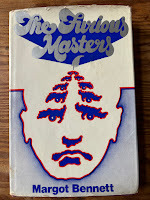 This is a review of a comic science-fiction novel from 1968, sort of John Wyndham done as sitcom. Yet in poking fun at the mores and anxieties of its time, there are things here worth a content warning for sexual violence.
This is a review of a comic science-fiction novel from 1968, sort of John Wyndham done as sitcom. Yet in poking fun at the mores and anxieties of its time, there are things here worth a content warning for sexual violence. Characters - male and female - repeatedly joke about rape and when one woman is stripped naked and murdered, it's played for comic effect. I'm not sure how much that's the author satirising misogyny of the period or being steeped in it herself and, given the overall light comic tone, I'm not sure how much that's on purpose. There's a lot going on under the surface.
At 3 am on 16 May, a sonic boom is heard across Yorkshire, trembling windows in Huddersfield and so terrifying the animals at a farm in Highfield-on-Moor that egg production drops by 40%. Two days later, farmer John Holman writes an angry letter to a government department to complain, believing the boom to have been caused by the RAF running exercises. The ministry denies any such exercise has taken place. Meanwhile, four precocious students from Oxford - Cressida, Robbie, Sue and David - go hiking across the moor and discover a strange object:
"The main body was a big, squat, metal cuboid, four feet high and over five across. On each side there were three-inch square slots, which on examination appeared to be filled with thick glass. The body was covered by a low pyramid, from which two long cup-ended tentacles projected at different angles. They looked very like aerials. A thick rod rose several feet above the pyramid to support two flat rectangular sheets of metal; one almost parallel to the ground, the other about ten degrees off the perpendicular." (p. 14)They're soon joined by photographer Henry Brown, who takes atmospheric snaps of Cressida in front of this "spacecraft" and then hurries down to London to sell them to the papers. Soon people are queuing up to see the "Martian" lander, Holman fencing off his land and charging entry. News reporters come by helicopter, the police turn out in force, the local vicar has a moral perspective on all these proceedings, and even the Prime Minister is making pronouncements on TV about what he thinks is going on, based more on what he'd like to think than the evidence on the ground.
In all this frenzy, it takes a while for the students - and the reader - to spot the effects that this lander seems to have on those who get close it. They become more frenzied, angry, violent... The title of the novel refers to the "furious masters of lust and violence" that govern our behaviour.
We get our first clue to what's going on just after Henry photograph Cressida, thrilled by the possibility that these pictures will make him famous. They're also both hot from the walk and the sunny day, and the heat given off by the "spaceship". Henry suddenly changes tack:
"'I wa thinking to hell with fame and what's the hurry [to get to London] and I should pull you down and...' He put his arms around her and rubbed his face against hers. 'And make love to you on this fine bouncy grass.'" (p. 19)Cressida initially seems keen but then a sheep bleats nearby and ruins the moment. Cressida admits that she likes Henry but thinks they should call the police to inform them about the lander. Henry persists:
"I should have raped you [but] I'm over-civilised" (p. 20).
Cressida laughs this off, but it's the first of many casual references to sexual violence. Later, this is linked to sexual liberation - or the lack of it:
"Cressida and Sue ran across the grass to the helicopter.
'Would you have minded being raped?' Sue asked in her shrill, clear voice, as they climbed on board.
'Yes.'
'With your inhibitions, naturally. I would have liked to be raped. It makes a nice change.'
'Being raped by one man is all very well. But I had two after me. And Sabine women aren't in this year.'" (p. 83)
The casual tone of all this is shocking, but surely a conscious choice by the author. In part, it's satirising sexual liberation. It's also not so different with the comments by members of the public from the time responding to the sexual assault depicted in The Forsyte Saga, which are included as extras on the DVD of that serial. But one big element of the novel is competing ideas about the cause of the increasing violence: whether it's something being done to us by the "spaceship" or something inside us all anyway that's been given an excuse to let rip. As Cressida and Sue have this conversation, is it a new or prevailing attitude?
As I said, much of the violence here is played for comic effect. When Cressida rebuffs Henry's advances, he resorts to attacking his own blown-up photographs of her. Another character makes a clumsy attempt to break into the bathroom when she's in there. In both cases, the threat is undercut by the inadequacies of these men. Later, as things get every more frenzied, another woman is stripped naked and murdered in a church as part of a kind of ritual sacrifice, but the vicar and congregation don sunglasses so as not to see anything rude.
A lot of these incidents feel like comic sketches. The novel is often funny and well observed, its targets including the press, police, church and civil service bureaucracy. There are some great one-liners:
"I must say Mars couldn't have chosen a more awkward time for the Minister." (p. 36)
But many of the gags are specifically visual in nature. Margot Bennett has a knack for conjuring vivid, strange images - such as this glimpse of the fauna of another world:
"Could the population of Mars, formerly supposed to consist of small snails, have devised a machine capable of driving human beings mad?" (p. 139)
Often, we "see" the comic events taking place, such as squabbles over who is in charge of a helicopter, or the top secret files raining down from an open window on to people rioting in the street. With its lively characters and set pieces, I could easily see this being dramatised - and perhaps Bennett, a prolific writer for TV, did so too. In fact, one reason I was so keen to read this novel is that it had been suggested to me that it originated in an idea Bennett may have offered Doctor Who.
Her name is listed in two internal BBC documents, one from 28 February 1964 and one undated but probably from 2 March, with the idea to commission a four-part story from her to cover the potential loss of what ultimately became Planet of Giants. Nothing else is known about what Bennett's story might have involved.
If it was the seed of what became The Furious Masters, I can see why it didn't go any further as a Doctor Who adventure. On 20 February, story editor David Whitaker declined a story by another would-be writer, David Fisher, on the basis that it was set in the 20th century; the production team wanted Doctor Who to visit other times and places. We don't know much about Fisher's The Face of the Fire, other than it involved the effects of a machine discovered under the Wessex Downs. If this didn't meet with approval, the same was surely true of an idea from Bennett about the effects of a machine found on the moors in Yorkshire.
I'm continuing to look into this, and have in sight Bennett's other science fiction novel, The Long Way Back (1955) and her non-fiction The Intelligent Woman's Guide to Atomic Radiation (1964). Note that the latter is from around the time she was mooted for Doctor Who, so perhaps that will provide further clues.
See also:
Me on The Man Who Didn't Fly, a detective novel by Margot BennettMe on The Victorian Chaise-Longue, a science-fiction novella by Marghanita Laski, another author considered for the first year of Doctor WhoBuy my biography, David Whitaker in an Exciting Adventure with Television Memoirs of the Spacewomen , a 2015 radio documentary about the work of Margot Bennett, Naomi Mitchison and Rose Macaulay, presented by Matthew Sweet and produced by Allegra McIlroyOctober 3, 2024
Doctor Who and the Time-Travelling Almanac, by me


It seems like only a week since my last book was out. But today sees publication of Doctor Who - The Time-Travelling Almanac , billed as the official guide to the Doctor's year. It is written by me and illustrated by brilliant Emma Price.
What is an almanac anyway? Why do we have August? How do the histories of the Beatles and the Doctor overlap?
Where exactly did the Doctor mean to take Romana instead of that beach at the start of The Leisure Hive? What are the tides on Kastarion 3 like?
All this and Dalek horoscopes, banana penguins, the best time of day for Sea Devils to invade and much more... HARDBACKISBN: 9781785949173Length: 256 pagesDimensions: 224mm x 23mm x 143mmWeight: 355gPrice: £16.99
PAPERBACKISBN: 9781473533943Length: 256 pagesPrice: £8.99
September 26, 2024
The Story of the Solar System, by Dr Maggie Aderin-Pocock
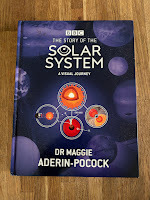 Out today,
The Story of the Solar System - A Visual Journey
, is a sumptuous big book of space infographics written by Dr Maggie Aderin-Pocock off of
The Sky at Night
with some help by me and design/illustration by Emma Price. Exactly what you and everyone you know wants for Christmas, if you even dare wait that long.
Out today,
The Story of the Solar System - A Visual Journey
, is a sumptuous big book of space infographics written by Dr Maggie Aderin-Pocock off of
The Sky at Night
with some help by me and design/illustration by Emma Price. Exactly what you and everyone you know wants for Christmas, if you even dare wait that long.(Emma and I have another book out next week, too...)
In case of interest, Solar System is the latest of the infographics books I've worked on, following Whographica (2016) written with Steve O'Brien and illustrated by Ben Morris, and Slayer Stats (2018) also written with Steve O'Brien and illustrated by Ilaria Vescovo. I also wrote the regular "Sufficient Data" infographics for Doctor Who Magazine, illustrated by Ben Morris and Roger Langridge.
I've written before about some of what' involved in producing an infographic. They are fiddly. And, if you're writing about space stuff, no sooner have you finished a complicated graphic showing all the moons of Saturns than those bothersome space scientists go and discover a whole load more.
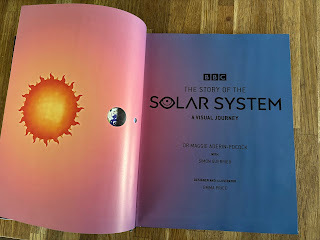
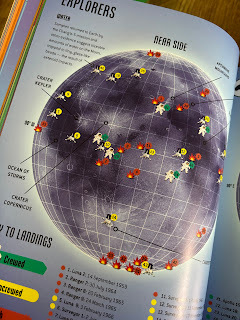
September 25, 2024
Garry Halliday and the Flying Foxes, by Justin Blake
 This is the last of the five Garry Halliday novelisations, published in 1965. That was three years after the last new episode of the TV series Garry Halliday was broadcast and two years after the last repeat.
This is the last of the five Garry Halliday novelisations, published in 1965. That was three years after the last new episode of the TV series Garry Halliday was broadcast and two years after the last repeat. The odd thing is that it marks a new beginning, the first adventure not to feature the villainous Voice and the first to feature potential new love interest Vicky Fox. It ends on a bit of a cliffhanger about Garry and Vicky's relationship...
Whatever the authors might have had in mind, it would have been very different on TV. Here, Vicky is left mourning her brother Nigel who, in giving his life, makes amends for some bad choices. On TV, Nigel survived and was part of the Garry Halliday series for all subsequent adventures.
I was particularly interested to read this novelisation because the TV version is credited to writer David Whitaker - about whom there is quite a good book. There’s no mention of David in the novelisation. He's not there in the indicia, where it is (c) 1965 Justin Blake - the pseudonym of John Bowen and Jeremy Bullmore, creators of Garry Halliday. I’ll dig into why not when I write up the production notes for the episode guide entry on this adventure.
After the events of the previous adventure and the death of the Voice, Garry and his co-pilot Bill Dodds return from Tripoli to their office/home on an airfield in Kent. There they discover that, in their absence, a rival charter airline has taken most of their business, undercutting their prices by 25%. Garry doesn’t exactly run his airline to get rich so the Flying Foxes company must be running at a loss to put him out of business. That means they’ve got money behind them. When Garry looks into it, and watches a flight coming into land (as seen on the cover of the book), he spots something suspicious. Soon, the trail leads him to Rome where a drug developed to prolong life has the opposite effect…
As before, it's a lively, fast-moving, twisty plot involving adventures overseas and some fun, funny set pieces. Sadly, new villain da Rica - aka "the spider" - isn't a patch on the Voice. He's an American hoodlum who takes copious amounts of the BDM drug that he's also involved in smuggling, but there's little sense of a personality. The Voice was so distinctive, he was a selling point for the series; da Rica is a bit generic.
It's odd, too, that the elements set in Rome come so late rather than being part of the sell of the new story from the start. Instead, the opening instalments are set in Kent, around the airfield where Garry Halliday is based and in a nearby lake. It's not especially exciting. When a villain then breaks into Garry's office/home, I was reminded of a similar sequence in the second story - the series repeating itself.
Even so, there's plenty of fun stuff here. One chapter opens by telling us that Bill Dodds "shows enormous intelligence and perspicuity" (p. 25) in what is to follow, underlining his active role in proceedings, and not merely as comic foil. When the plot involves convincing the public that Garry has been killed, Bill gamely heads up to BBC TV Centre and then takes part in a live interview for Tonight in the studios at Lime Grove, with a cameo by real-life presenter Cliff Michelmore. That's not mentioned in the scant surviving paperwork relating to the series - I wonder if it happened on screen?
The supposed death of Garry Halliday causes some problems for the plot. The "death" is contrived to fool da Rica, who duly reads obituaries in the press. But the plot also involves da Rica and his henchperson Luigi not knowing what Garry looks like and so mistaking him for someone else. Presumably at least one obituary ran a photograph.
Similarly, the plot involves smuggled quantities of the age-defying drug, BDM. Before scientific analysis identifies what this is, Garry tries some of it to test that it's not cocaine or heroin - which I don't think is best practice for airline pilots. Other characters also try the drugs. They continue to do so even after it becomes apparent that one batch of the drug is in fact deadly.
The novelisation is surely based on the original storyline and scripts that Bowen and Bullmore delivered before they were reworked by in-house writer David Whitaker, in liaison with uncredited script editor Richard Wade and producer Richard West. It's difficult to know how different the TV version was - though, as I'll detail when I get to the production notes on the episode guide - Bowen and Bullmore clearly felt it departed a great deal from what they'd intended.
But one practical change is evident. In the novelisation, drugs are tested on 20 batches of rabbits, labelled A to J. The chapter "The Secret of Batch J" reveals that one of these batches is deadly. On TV, the same instalment was "The Secret of Batch 3", suggesting a reduced scale, perhaps no more than three hutches, manageable on set.
I wonder, too, how much a moment in which Sonya Delamere - Bill Dodd's fiancee, a returning character who has so little to do in this serial - watches the new girl reflected feelings of the cast.
"The little pang of jealousy Sonya felt was because Vicky was going off to do the kind of thing she used to do herself. But Sonya knew well enough why Vicky had to do it, and being a sensible girl, she stifled her pang, and kept it to herself." (p. 76)
It's an engaging, exciting story but what tantalises me most is how accurate a record it is of the TV version and of what the cast and crew may have felt.
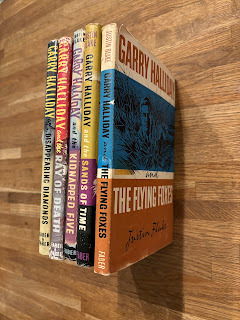
September 23, 2024
The Masquerades of Spring, by Ben Aaronovitch
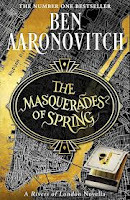 This is great fun - a Rivers of London novella set in New York in the Jazz Age, narrated by the woosterish Augustus Berrycloth-Young. Gussie has fled London and the stern wizards of the Folly because he's been using magic for daft pranks. Then Thomas Nightingale turns up on his doorstep, seeking help to track down a magic saxophone...
This is great fun - a Rivers of London novella set in New York in the Jazz Age, narrated by the woosterish Augustus Berrycloth-Young. Gussie has fled London and the stern wizards of the Folly because he's been using magic for daft pranks. Then Thomas Nightingale turns up on his doorstep, seeking help to track down a magic saxophone...It's a fast-moving, quick-witted caper, full of pithy one-liners but grounded in the real history of the jazz and drag scene, prohibition, racism and homophobia. That makes it sort of Dashiell Hammett as written by PG Wodehouse, with some magic mixed in - and not nearly as easy to pull off as Ben makes it look.
Of course, he has form here. That use of a specific time and place to add some heft to the adventure is the same trick as in Ben's Remembrance of the Daleks (which I adore). Just as that story hinted at hitherto unknown secrets in the Doctor's past, this novella provides some tantalising clues about the early life of Thomas Nightingale.
There's another link to Ben's TV Doctor Who in that Peter Walmsly is, here on p. 29, a reverend who led prayers at Casterbrook school of wizardry, decades before his stint as an archaeologist for the Carbury Trust.
I found it compelling and read it in a day. It closes with the prospect of many more such adventures for some of the principal figures here. Yes, please.
Rivers of London novels I've also blogged about:
Lies Sleeping False Value Amongst Our Weapons Rivers of London novellas: What Abigail Did That Summer The October ManSeptember 21, 2024
Doctor Who and the Left-Handed Hummingbird, by Kate Orman
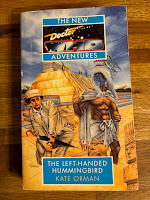 Someone is meddling with time. That means that when an Aztec warrior ventures into a long abandoned Exxilon spaceship, he isn't instantly killed by the radiation bleeding from its systems. Instead, Huitzilin - his name meaning "southern warrior" and also "left-handed hummingbird" - becomes something like a god. Some 500 years later, the Doctor and his friends arrive in Mexico City in 1994 to find they're late for an adventure and must head back to multiple points in time to catch up...
Someone is meddling with time. That means that when an Aztec warrior ventures into a long abandoned Exxilon spaceship, he isn't instantly killed by the radiation bleeding from its systems. Instead, Huitzilin - his name meaning "southern warrior" and also "left-handed hummingbird" - becomes something like a god. Some 500 years later, the Doctor and his friends arrive in Mexico City in 1994 to find they're late for an adventure and must head back to multiple points in time to catch up...I've not read The Left-Handed Hummingbird since it was first published in November 1993 - the official publication date was December, but there's a moment in this that I suddenly, madly remembered first reading the night before my driving test so it must have been out the month before. Yet this odd, extraordinary book scored its way into my brain. Reading it again after more than 30 years, it was immediately, vividly familiar, like catching up with an old friend.
Two things surprised me. First, for what I remember as Kate Orman's radical debut, the plot is quite straightforward, even slight. The Doctor and his pals Ace and Bernice are on the trail of "the Blue", ie Huitzilin, which has the power to take people over and make them violent. That includes the Doctor and his friends - all providing Huitzilin with fuel so that he can become corporeal once more. But the more the Doctor is taken over, the more he can see what Huitzilin thinks and feels. And the more Huitzilin becomes corporeal, the more he can be tackled head on...
What makes this so different is the way that it's told, beginning in 1994 - the future, when the book was published - and then dancing back to multiple points in time to piece together the story. Telling a story out of order was a big innovation, perhaps oddly for a long-running series about gadding back and forth in time. And then the novel makes us realise that the pieces don't quite fit because time is in flux and changing. I'm conscious now, as I wasn't at the time, how big an influence this was on my debut novel.
The way it's told includes things we'd never do today. The violence is horrific and vivid, rather than PG or 12A. The Doctor takes magic mushrooms and LSD to communicate with his enemy. One of his companions is a gun-totting solder who kills people with little qualm and reneges on her agreement with the Doctor not to use violence; the other companion kills a man by bashing him with a cooking implement. This book is all set on Earth and yet reading it is a journey to another world.
Secondly, the book is chock-full of references to other Doctor Who, on TV and in print. That's not a criticism - these were books squarely aimed at fans, and I ate up this continuity with greed at the time but was grateful to the entry on this novel in the Cloister Library when trying to remember other books I've not read in more than 30 years. For the most part, you don't need to be able to place these references to enjoy or be caught up in the story. But then there are the exceptions.
I think the assumed/required knowledge of the reader is 1964 story The Aztecs, which was readily available to fans at the time of publication having been released on BBC Video on 2 November 1992, and 1974 story Death to the Daleks, released on video July 1987. These TV stories also inspired two of the best novelisations, too. This kind of thing occupies my head a lot in what I write day to day - how much we can assume fixed points of Doctor Who, the nodes by which we all navigate, as opposed to the obscure stuff that is manna for the dork hardcore (my people). See, for example, what I said about authority as it relates to The Unfolding Text.
But also, amazingly, there are several references to other Doctor Who stories here that the Cloister Library doesn't cover. Perhaps fittingly for a story that plays with chronology and the unfixedness of time, there are the references in this novel to multiple Doctor Who stories from after it was published. When the Doctor is gravely wounded, his friends are asked why they don't rush him to hospital.
"'Because he's from outer crukking space,' spat Bernice. 'A crukking twentieth-century hospital would probably do a crukking brilliant job of killing him.'" (p. 177)
Which, of course, is exactly what happens to kill off this incarnation of the Doctor in the TV movie Doctor Who (1996). Later in the novel, Ace pulls out her gun only to find that the Doctor has swapped it for a potato, years ahead of him pulling the same trick (with a banana) on Captain Jack in The Doctor Dances (2005). Then the TARDIS lands on Abbey Road (p. 201), as it does in The Devil's Chord (2024).
A few other small things occur. Bernice Summerfield, a 26th-century archaeologist of the 20th century, doesn't know what pizza is (p. 71) or how to open tins (p. 73), and doesn't have much to do. When she reveals, at the end, that she doesn't get to do much archaeology while travelling in time and is thinking of leaving the TARDIS, I could well understand why. I doubt I was conscious of all this when I first read the novel; now I'm all too aware of the note from my editors to ensure the regular characters are always well served.
Something very of its time is the frequency with which the author refers to the Doctor as "the Time Lord". Yes, she also refers to Bernice as "the archaeologist" (p. 238) and Cristian as "the Mexican" (p. 259), but there are far more second mentions of the Doctor as Time Lord, which I don't think a Doctor Who novelist would do now. If nothing else, this incarnation of the Doctor, in the crumpled linen suit of the novels, is one of the least assuming Doctors visually, a man we'd fail to notice in a crowd who is yet a near god-like alien in our midst. Referring to him, a lot, as "the Time Lord" is a convention, a fashion, of the time when this novel was written but I think it'a also the wrong cue for what we "see" - as if this unassuming fellow were wearing a big robe and collar.
And then there's the other strong visual elicited by this reread: of me, aged 17, utterly absorbed by this book, this series, this gang of authors I so much wanted to be part of. There's a bit towards the end of the novel where the Doctor handles a powerful book that glows with light. It's been fun to return to this book that shone so brightly in my formative years and has stayed with me so long after. Thank you, Kate.
See also:
My own, awful first idea for a Doctor Who novel which I submitted in 1994Me on the 1992 Doctor Who novel Nightshade by Mark GatissSeptember 16, 2024
The Voice of the Dolphins, by Leo Szilard
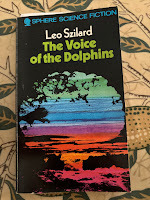 Prompted by Richard Flanagan's Question 7, I sought out this "science-fiction" anthology by the Hungarian physicist Leo Szilard (1898-1964). He's an extraordinary figure, the man who conceived and patented the idea of the nuclear chain reaction, inspired by The World Set Free by HG Wells (in which Wells coined the term "atomic bomb"). In 2015, I made a documentary about this, HG and the H-Bomb, where we spoke to Liza Jardine about her memories of "Leo", a good friend of her father's. But I didn't know that Szilard himself wrote sci-fi.
Prompted by Richard Flanagan's Question 7, I sought out this "science-fiction" anthology by the Hungarian physicist Leo Szilard (1898-1964). He's an extraordinary figure, the man who conceived and patented the idea of the nuclear chain reaction, inspired by The World Set Free by HG Wells (in which Wells coined the term "atomic bomb"). In 2015, I made a documentary about this, HG and the H-Bomb, where we spoke to Liza Jardine about her memories of "Leo", a good friend of her father's. But I didn't know that Szilard himself wrote sci-fi.It's a short, quirky collection, comprising the following:
pp. 7-12 "Nightmare for Future Reference" (1938) by American poet Stephen Vincent Benét (1898-1943), from the Selected Works of Stephen Vincent Benét
Some time in the future, the unknown narrator addresses an 18 year-old who was one of the last to be born before, during the Third World War, the birth rate collapsed. pp. 13-68 "The Voice of the Dolphins" (1960)Written sometime after 1998 (p. 35), an account of the years 1960-85 and the way intelligent dolphins helped end the nuclear stalemate (for more on which, see below).pp. 69-79 "My Trial as a War Criminal" (1947), reprinted from The University of Chicago Law Review, vol. 17, no. 1, Autumn 1949.During the Third World War, a virus kills American children and the country surrenders to Russia, whereupon Szilard, Henry L Stimson, President Truman and James F Byrnes are put on trial for their roles in the Manhattan Project.pp. 81-94 "The Mark Gable Foundation" (1948)In 1960, the narrator is put in suspended animation and woken in 2050, where no one has teeth and women choose to impregnate themselves with the seed of a small number of celebrities. The narrator is now such a celebrity.pp. 95-100 "Calling All Stars" (1949)A radio message from the planet Cybernetica warns of odd readings detected in the atmosphere of the planet Earth, from which the cybernetic people deduce biological inhabitants, evolution and nuclear war - and warn others to be wary.pp. 101-107 "Report of 'Grand Central Terminal'" (1948), reprinted from The University of Chicago Magazine, June 1952.A report by aliens on their exploration of the extinct planet Earth, and their deductions about the life forms that once lived here based on aspects of Grand Central Station, such as the coin-operated toilets.pp. 108-111 "Kathy and the Bear" (no date)The author relates two meals with four year-old Kathy and her mother at a hotel, and the child's conversations with a bear skin hanging there.pp. 112-126 "The Mined Cities" (no date), reprinted from Bulletin of the American Scientists, December 1961 - vol. XVII, No. 10.A conversation between "A" and "B" in 1980, looking back on a convoluted system to avoid nuclear annihilation by having Americans mine a Russia city and be ready to blow it up (and themselves), and vice versa.The title story seems to have been prompted by real-life John C Lilly claiming, in the year the story was written, that "dolphins might have a language of their own" (p. 15). We learn from Szilard that one of the few recommendations of the President's Science Advisory Committee to bear fruit is "a major joint Russian-American research project having no relevance to the national defense, or to any politically controversial issues" (p. 14). Instead, the Biological Research Institute in Vienna, established in 1963, focused on dolphin intelligence.The institute quickly established that dolphins are highly intelligent. We learn, from a book published in 1998, that,
"the dolphins, who grasped mathematics, chemistry, physics and biology with ease, found it difficult to comprehend America's social and political system" (p. 35)With the dolphins' help, the Vienna Institute develops a cheap food that has the side-effect of lowering birth rates and so solves the problem of over-population. From the licence paid on this best-selling food stuff, the institute has the financial backing to reshape the world. We follow the various, complex schemes and politics. Then, with the nuclear threat averted, questions are raised as to whether the dolphins really were intelligent - implying that the American and Russian scientists between them have duped and saved us all.
Within this fun wheeze, Szilard tells a sprawling future history, predicting the revolution in Iran if not the exact date, and poking fun at various subjects, often with the eye of an outsider. With its new-earned wealth,
"The first major investment made by the Vienna Institute was the purchase of television stations in a number of cities all over the world. Thereafter, the television programs of these stations carried no advertising. Since they no longer had to aim their programs at the largest possible audience, there was no longer any need for them to cater to the taste of morons." (p. 18)I wonder if he had advert-free BBC Television in mind as the saviour of humanity. There are jibes on the way the two-party system in America favours minority rule since a few per cent of voters with some strongly held view on a particular issue can determine which of two candidates wins (p. 33). On the same page, he cites "Szilard's diary, recently published by Simon and Schuster" - that is, some 40 years after this was written - to show he was right all along about allowing China to join the United Nations.
There's something similar when an extended footnote details the way in which an article by Szilard in the February 1960 issue of the Bulletin of the Atomic Scientists was initially misunderstood.
"After his death, Szilard appears to have received some recognition, however, from his Russian colleagues, who names a small crater after him - on the back side of the moon." (p. 28)Even the way he refers to the far side is a joke. In fact, there is a Szilard crater, named in 1970 and on the near side of the moon.
The playful and mischievous tone continues through much of what follows. In "My Trial as a War Criminal", the Russians develop a virus that predominately kills children. This was never to be used, and only kept in case of emergency. A later, more advanced virus was intended for use in war.
"It would not affect children at all and would kill predominately men between twenty and forty. Owing to the premature outbreak of the war, however, the Russian government found itself forced to use the stocks which it had on hand." (pp. 69-70)
This is grim humour from a man so closely associated with the development of nuclear weapons he then failed to contain, and well understood the bureaucracy involved in unleashing weapons of mass destruction. There's a similar caustic wit as he considers the option of a new life in Russia, having already lived in Hungary, Germany, England and the US.
"When you are above fifty you are no longer as quick at learning languages. How many years would it take me to get a sufficient command of Russian to be able to turn a phrase and to be slightly malicious without being outright offensive?" (p. 71)
The twist at the end of the tale is that Szilard and his fellows escape the inevitable guilty verdict when the Russians fall victim to their own virus. That's a consistent idea in this book. These weapons are not something we use on other people; whoever unleashes them, we all lose.
The last story, set in 1980, was first published in The Bulletin of the American Scientists in 1961, and includes "B" asking "A" who first thought up the convoluted idea of "mined cities".
"B: Szilard had proposed it in an article published in The Bulletin of the American Scientists in 1961, but the idea may not have been original with him. His proposal was presented in the form of fiction and it was not taken seriously." (p. 120)
The argument then follows, and repeats almost word for word, some of what was covered in "The Voice of the Dolphins" - which Szilard then acknowledges, but says is a complete coincidence.
"A: I read The Voice of the Dolphins when I was ill in the hospital; I remember that it contained many rather crazy prediction, but what they were, I do not recall." (p. 126)
It's a daft book full of complicated, intricate ways to prevent nuclear annihilation - none of them madder than the real predicament facing the world. I've read and heard a lot about Szilard and his rather odd perspective and humour - he was, says Richard Flanagan, one of the Hungarian scientists known as "the Martians" because they were so odd.
The blurb for this book refers to his "wry sense of humour and a heartfelt fear for the future of mankind". More than anything, there's a playfulness here, following any daft idea to its logical end. But what did Einstein, or President Truman, make of this strange fellow and his extended flights of fancy. I suspect he was exhausting.
September 15, 2024
Dead Lions, by Mick Herron
 How do you bring an audience up to speed on the story so far?
How do you bring an audience up to speed on the story so far?I posted in April that the surviving episode of children's adventure serial Garry Halliday (from 1960) begins with a minute-long recap, showing stills of 10 different characters and detailing multiple twists. As I said, we can compare that to the opening moments of a rare, surviving episode of soap opera Compact (from 1962), where there's no narrated recap but everything we need to know is relayed concisely in the opening scene.
The second Slow Horses novel bring us up to speed from the perspective of an imaginary cat stalking the offices of Slough House floor by floor, describing the disgraced intelligence operatives working there. That includes the two new characters replacing characters killed in the first novel. It's a bold conceit for a series grounded in the grubbily, boringly and compellingly real and could fast become wearying. But, kept to just an introductory sequence and used to delineate the distinctive features of each of the main characters, I think Mick Herron gets away with it.
The sequence ends with a pen portrait of slovenly Jackson Lamb on the top floor who would, if the cat really existed, throw it out of the window to its death. The point is that Lamb is quicker and more ruthless than he might appear, and in the story that follows his long experience and cynical perspective mean he's the one intelligence operative not to be fooled...
Once again, the TV version - which I came to first - is a very close adaptation of the book, the main difference that a final confrontation with a baddie involves young River Cartwright in the book and Jackson Lamb on TV. River was the protagonist of the first book and TV series, but we're already seeing the focus shift. It's the same phenomenon, I think, as Captain Picard in Star Trek: The Next Generation or President Bartlett in The West Wing. Each was originally envisioned as a kind of guest star who'd appear infrequently to offer wise counsel, while the focus was on the ordinary staff getting into scrapes and adventures. The issue, I think, is that the authority of such characters exerts something like gravitational force, and the more a series continues, the more it is drawn to that power.
The novel ends with another tour of Slough House, this time from the perspective of a mouse. It's effectively the punchline to a book-long joke. I wasn't at first sure whether this was another hypothetical creature but it turns out to be real - and prompts Jackson Lamb to wonder if they need a cat.
Simon Guerrier's Blog
- Simon Guerrier's profile
- 60 followers



